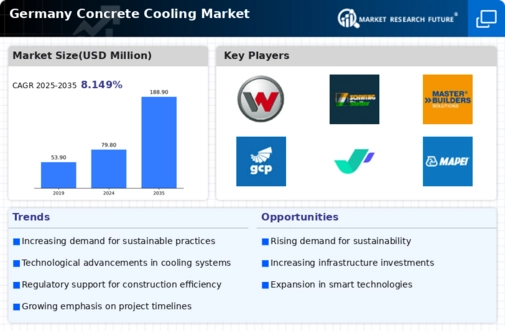Regulatory Compliance
The concrete cooling market in Germany is influenced by stringent regulations aimed at ensuring construction quality and safety. Compliance with these regulations necessitates the use of effective cooling methods to prevent issues such as thermal cracking. As regulatory bodies enforce stricter guidelines, construction companies are compelled to adopt reliable cooling solutions. This trend is expected to drive the demand for concrete cooling systems, as firms seek to meet compliance standards while maintaining project timelines. In 2025, the market is projected to expand by 15% due to the increasing emphasis on regulatory compliance, highlighting the critical role of cooling technologies in the construction process.
Climate Considerations
Germany's climate presents unique challenges for the concrete cooling market. With rising temperatures and heatwaves becoming more frequent, the need for effective cooling solutions is increasingly apparent. The concrete cooling market must adapt to these climatic changes, as elevated temperatures can lead to thermal cracking and compromised structural integrity. In response, construction companies are investing in advanced cooling technologies to maintain optimal curing conditions. This adaptation not only enhances the quality of concrete but also aligns with the growing emphasis on sustainability in construction practices. As climate considerations become more pronounced, the concrete cooling market is likely to see a shift towards innovative cooling methods that address these environmental challenges.
Technological Innovations
The concrete cooling market in Germany is witnessing a wave of technological innovations that enhance cooling efficiency. Advanced cooling systems, such as chilled water systems and liquid nitrogen cooling, are gaining traction among construction firms. These technologies not only improve the curing process but also reduce energy consumption, aligning with the industry's sustainability goals. In 2025, it is estimated that the adoption of these innovative cooling solutions could increase by 20%, driven by the need for faster project completion and improved concrete quality. As the market evolves, companies that invest in cutting-edge cooling technologies are likely to gain a competitive edge, further propelling the growth of the concrete cooling market.
Rising Construction Activities
The concrete cooling market in Germany is experiencing growth due to the increasing number of construction projects. With urbanization and infrastructure development on the rise, the demand for concrete cooling solutions is likely to escalate. In 2025, the construction sector is projected to grow by approximately 3.5%, leading to a heightened need for effective cooling methods to ensure the integrity of concrete. This trend is particularly evident in large-scale projects such as bridges, highways, and commercial buildings, where temperature control is crucial. The concrete cooling market is thus positioned to benefit from this surge in construction activities, as contractors seek reliable cooling solutions to mitigate the risks associated with high temperatures during the curing process.
Growing Awareness of Quality Control
There is a growing awareness of the importance of quality control in construction, which significantly impacts the concrete cooling market in Germany. As stakeholders recognize the correlation between proper cooling and the durability of concrete structures, the demand for effective cooling solutions is likely to rise. This awareness is particularly relevant in high-stakes projects where structural integrity is paramount. In 2025, it is anticipated that investments in quality control measures, including advanced cooling technologies, will increase by 25%. This trend underscores the necessity for construction firms to prioritize cooling methods that ensure optimal curing conditions, thereby enhancing the overall quality of concrete.


















Leave a Comment